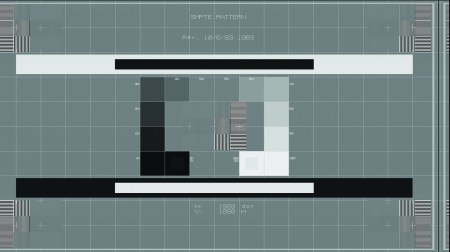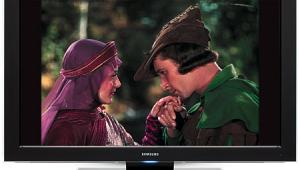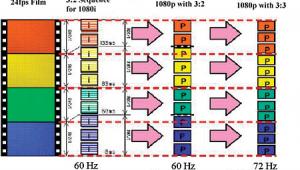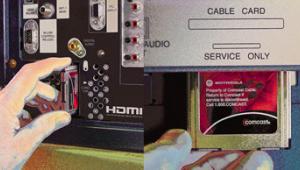Are You Getting All of the HDTV Resolution You Expected? Round 2

It's now time for the 2006 models, and we have tested 61 new HDTVs using the 1080i HDTV format that most of the HDTV channels use (including CBS, NBC, CW, MTV HD, and Wealth HD), as well as the current HD DVD and Blu-ray disc players. The question is, does the latest crop of HDTVs retain all of the detail in the broadcast or HD disc and send it to the screens at its native resolution? Or do they fail to properly handle the signal, cutting the image resolution down by as much as 50 percent?
A 1080i (broadcast or Blu-ray/HD DVD) signal, is created by transmitting each frame in two parts called fields. The first field is broadcast in 1/60 of a second and consists of odd-numbered horizontal lines, followed in the next 1/60 of a second by the even-numbered horizontal lines. Together, they can create a full-resolution, 1,080-line frame.
Some TVs take every one of the 1,080 interlaced lines and convert them to a progressive signal. This process is known as deinterlacing. It compensates for any motion in the image and sends it to the screen at its native resolution. Other HDTVs may take a cheaper shortcut and simply upconvert each single 540-line field. The latter process can result in a loss of up to 50 percent of the image's resolution (for a 1080p display).
For the 2006 model year, we have added two tests: one for 3:2 conversion of 24-frame-based sources and another for detecting whether the set passes the full signal bandwidth to the screen. The test patterns come from Silicon Optix's new high-definition 1080i HQV test disc played on the Toshiba HD-XA1 HD DVD player. The disc contains a number of display-evaluation test signals and other content and should be available to consumers by the time you read this.
Deinterlace Test
The 1080i SMPTE 133 test pattern from the disc contains an image. In the corners and to the right of the middle of the image are boxes with alternating horizontal black and white lines a single pixel high. (See the illustration directly below - note: some detail was lost shrinking the image to fit the web) The TV sends the white lines (odd numbered) to the first field, and the second field contains the black lines (even numbered). To add a motion component (proper deinterlacing of still frames doesn't count since we are dealing with "motion" pictures, not a slide show), a clockwise rotating white line is positioned on the left side of the pattern. If a given display properly processes all of the lines, the pattern's alternating horizontal lines should remain intact. If the display only shows single 540-line fields (all odd- or all even-numbered lines) and upconverts to the TV's native resolution, the boxes will strobe all black and then all white. If this occurs at any time, I give the display a "fail," because the display only works with half of the available information as it strobes.

3:2 Tests
Many scripted television and all film-based movies that telecast in 1080i HD are recorded at 24 frames per second. For broadcast, this is converted from film or 1080p/24 video to 1080i/30 using a telecine conversion. A good internal processor should use a method called HD inverse telecine to recognize like frames and reconstruct them for a 60-frame-per-second display using a 3:2 cadence. If the processor reconstructs the image properly, you'll see all 2-million-plus pixels of information in the original source material (on a 1080p display). A 720p display will downconvert the full 1,920-by-1,080 image to 1,280 by 720.
Without HD inverse telecine, the television's processor may discard up to half of the image resolution (prior to conversion in 720p displays) during horizontal pans. So, regardless of what you may have read elsewhere-or what your local TV-store sales clerk has told you-if a 1080p display's processor is capable of content based on HD 3:2 inverse telecine (and properly deinterlaces, as well), you can see all of the content in full 1080p resolution. You don't need to wait for 1080p broadcast or HD DVD disc players with 1080p output to do so.
This test also uses the SMPTE 133 pattern (without the addition of the rotating white line) "panned" right to left and back again at 24 frames per second. The Silicon Optix 1080i HQV HD DVD is mastered at 1080i/30 with a 3:2 cadence inserted, like any 24-frame film transfer to video.
If the processor properly handles the signal, the boxes with the horizontal lines described above will remain intact. If not, either the boxes will strobe between all black and all white (as with the deinterlace test), or you will see vertical bands on the sides of the box. (See image directly below) Strobing or banding constitutes a "fail," as resolution will drop during pans.

Bandwidth Test
I performed this test on the 1080p displays. The SMPTE 133 pattern has boxes with alternating black and white vertical lines. The lines in five of the boxes in the test signal are one pixel wide, representing the finest detail in a 1080i signal. If the display passes the full bandwidth, you'll see vertical black and white stripes. If there is an attenuation of the signal-which may translate into a loss of some fine detail in actual content-the lines will appear as dark gray alternating with light gray. If you can't see any lines, the display is not passing any fine detail to the screen. This means that a display can be native 1080p, with 1,920 pixels across, but no detail that is one pixel wide will make it to the screen. I've noted the sets that showed some signal attenuation with "some."
The Results
The 61 2006 models came from 17 different vendors and include store brands such as Polaroid (found in Circuit City) and Insignia (Best Buy). All results in the chart are based on the factory default settings, although four of the sets would pass certain tests when I changed a given setting in the display's user menu. These changes are noted in the chart.
First up was the deinterlacing test. The bad news is that 54.09 percent of the 61 sets failed. The good news is that the HDTVs from Hitachi, JVC, and Pioneer all passed, just as these manufacturers claim in their respective literature. Mitsubishi has upgraded their 1080p DLP rear projectors' processors in the time since their 2005 models failed. Now they all pass. Sharp has a number of 2006 sets that passed, whereas, last year, all of their models failed.
The 3:2 test results were far more disastrous, with a failure rate of 80.33 percent. But sets by JVC, Pioneer, and Hitachi (see notation) passed this one, as did a number of other manufacturers' products, although there were some mixed results, depending on the specific model.
The bandwidth test results were very interesting. Since I measured the sets, Sony claims to have made a production change in their latest 1080p rear projector (KDS-50A2000) to correct its failure in the test, which is a testament to the importance of full bandwidth in 1080p displays. With this modification, and after changes in the user menu of other Sony models (see chart), all of the 1080p sets passed, although all but one of them attenuated the pattern.
While good signal processing for proper deinterlacing, 3:2 conversion, and bandwidth is extremely important to obtain a superb high-definition picture, there are some other factors-including contrast ratio, motion lag, and black level-that make big differences in picture quality. Use the chart to find the sets that pass, and then compare the passing sets with other displays. If the other factors are about the same, the HDTV with the proper signal processing will produce the better image.
 Can't read it? Click here
Can't read it? Click here
33 of 61 Fail = 54.09% 49 of 61 fail = 80.33%
Key
L=LCD Flat Panel • P= Plasma Flat Panel • DLPRP=DLP Rear Projector • LCDRP= LCD Rear Projector • LCOSRP= Liquid Crystal On Silicon Rear Projector includes SXRD and DILA • FPLCD= LCD Front Projector • FPDLP= DLP Front Projector • NA=Not Applicable
* Sharp fails in factory default setting of Fast mode; will pass if user menu changes to Slow mode
** This deinterlace test fails in factory default DRC 2 setting; passes if manually changed in user menu to DRC1 or Off
*** This Hitachi fails the 3:2 test in factory default setting of standard mode; passes if user menu changed to Auto Film mode
**** This Sony fails the bandwidth test in factory DRC setting of DRC 2; will show highest frequencies if DRC is changed to Off or DRC 2 setting; TV does highest frequencies with DRC changed to the Off position
***** In-store demo; Sony claims sets made after August have been modified and will now pass this test


























































